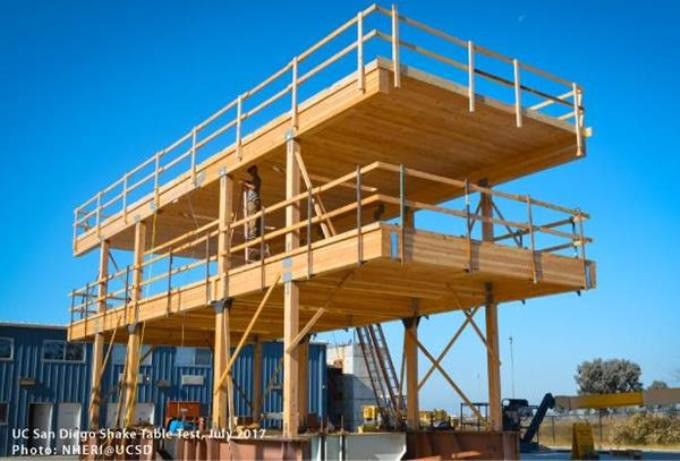Oct 25 2017
At a time when builders, designers, and engineers have to find solutions for a resource constrained situation, new wood technology, materials and science are expediting efforts to improve safety and structural performance.
 UC San Diego Shake Table Test, July 2017. Photo: NHERI@UCSD
UC San Diego Shake Table Test, July 2017. Photo: NHERI@UCSD
According to International Building Code, all building systems, despite of materials used, have to perform to the same level of safety and health standards. These codes have long recognized the performance capabilities of wood, allowing its use in a broad range of low- to mid-rise residential and non-residential buildings. In addition, wood often surpasses concrete and steel in terms of strength and durability, fire safety, seismic performance, and sustainability, among many other qualities.
Strength and Durability
Wood is one of the oldest building materials familiar to mankind. Wide research and documented experience have brought about several proven strategies to ensure that wood buildings attain their full potential for longevity. Next-generation wood products, also called mass timber, provide excellent strength and stability, making wood a viable choice to concrete or steel in several building applications. Products such as glue-laminated timber (glulam), cross-laminated timber (CLT), and nail-laminated timber (NLT) are also enabling increased strength, design versatility, and dimensional stability to improve project detailing.
There are countless examples of timber structures around the world that are several hundreds of years old, here in the U.S.there are old heavy timber buildings, 100+ years old that are being rehabilitated for creative uses. If protected and maintained properly, there is no reason mass timber buildings can’t exhibit this same level of longevity and durability.
Eric McDonnell, associate at KPFF Consulting Engineers.
Fire Safety
Fire can be efficiently controlled in wood buildings if appropriate fire protection systems are in place. Design and engineering analysis, together with supporting industry research, reveals that wood not only meets strict fire safety requirements, but also it often exceeds them. In particular, mass timber allows inherent fire resistance through its natural charring process. Steel can conduct heat and lose strength even in low-temperature fires. Furthermore, new wood buildings cover the steel bolts holding their beams together inside the wood in order to create a protective layer over the steel.
“Fire engineering strategies must provide the code-required level of safety at each stage of the design process, from building construction to occupancy,” stated Robert Gerard, senior fire engineer at Katerra. “Through meticulous design and implementation – as well as peer-to-peer education among industry professionals – we’re working to demonstrate mass timber’s exceptional fire safety performance.”
Seismic Performance
Although earthquakes cannot be prevented, good design and construction based on testing, research, and compliance with building code requirements can reduce their effects. Wood’s seismic advantages are commonly attributed to its detailing, ductile connections, light weight, and redundant load paths in North America, where wood-frame construction is common.
Seismic forces are proportional to a structure’s weight, and wood is substantially lighter than steel or concrete, these lighter wood buildings mean smaller foundation loads and a better performing structure in a seismic event.
Benton Johnson, associate at Skidmore, Owings & Merrill.
Sustainability
As the population continues to rise across the world, so does the demand for building materials and the requirement for affordable, sustainable housing in sprawling urban areas. With rising pressure to minimize the carbon footprint in the environment, building designers and developers are more and more looking to balance cost objectives and functionality with reduced environmental effect. Wood delivers more environmentally and economically and can help attain that balance. Furthermore, wood is the only building material that has third-party certification programs in place in order to verify that products come from a sustainably managed and renewable resource.
“It’s important to make advancements in wood buildings because we need more sustainable building materials – and more building systems that can build density in our cities in a sustainable fashion,” stated Joe Mayo, architect at Mahlum.
With the right resources and design techniques, the possibilities of wood are almost unlimited, providing buildings that will perform well for occupants, owners, and the environment for centuries.